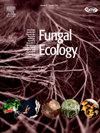Lichen secondary chemistry variation across environmental gradients in Arctic Alaska: Possible targets for functional trait exploration
IF 2.2
3区 环境科学与生态学
Q3 ECOLOGY
引用次数: 0
Abstract
Studies abound describing community structure of lichens across various landscapes. However, much of this work only uses lichen identity and abundance, with fewer studies using functional traits to describe these patterns. We believe that lichen chemistry represents a promising possible functional trait with which to investigate lichen ecosystem function, but current literature has yet to define species targets for investigation. We developed a bibliographic database of secondary metabolites documented to occur in Arctic lichen species. Using these chemical data, in conjunction with existing field datasets across the Arctic National Parklands, USA, yielded species abundance-weighted mean chemical frequency. Ordination analysis revealed three primary gradients in lichen chemistry. We found that lichen chemistry community patterns were not random. We recommend nine secondary chemicals, which are strongly associated with these environmental gradients as targets for future chemistry-based functional trait research. This novel approach has utility well beyond simply characterizing the community through the lens of lichen chemistry.
北极阿拉斯加地衣次生化学变化的环境梯度:功能性状探索的可能目标
大量研究描述了地衣在不同景观中的群落结构。然而,这些工作大多只使用地衣的身份和丰度,很少有研究使用功能特征来描述这些模式。我们认为地衣化学是研究地衣生态系统功能的一个很有前途的功能特征,但目前的文献尚未确定研究的物种目标。我们开发了一个记录北极地衣物种次生代谢物的书目数据库。利用这些化学数据,结合美国北极国家公园现有的野外数据集,得出了物种丰度加权平均化学频率。排序分析揭示了地衣化学的三个主要梯度。我们发现地衣的化学群落模式不是随机的。我们推荐与这些环境梯度密切相关的9种二级化学物质作为未来基于化学的功能性状研究的目标。这种新颖的方法的实用性远远超出了简单地通过地衣化学来描述群落的特征。
本文章由计算机程序翻译,如有差异,请以英文原文为准。
求助全文
约1分钟内获得全文
求助全文
来源期刊

Fungal Ecology
环境科学-生态学
CiteScore
5.80
自引率
3.40%
发文量
51
审稿时长
3 months
期刊介绍:
Fungal Ecology publishes investigations into all aspects of fungal ecology, including the following (not exclusive): population dynamics; adaptation; evolution; role in ecosystem functioning, nutrient cycling, decomposition, carbon allocation; ecophysiology; intra- and inter-specific mycelial interactions, fungus-plant (pathogens, mycorrhizas, lichens, endophytes), fungus-invertebrate and fungus-microbe interaction; genomics and (evolutionary) genetics; conservation and biodiversity; remote sensing; bioremediation and biodegradation; quantitative and computational aspects - modelling, indicators, complexity, informatics. The usual prerequisites for publication will be originality, clarity, and significance as relevant to a better understanding of the ecology of fungi.
 求助内容:
求助内容: 应助结果提醒方式:
应助结果提醒方式:


